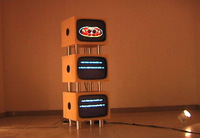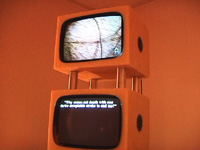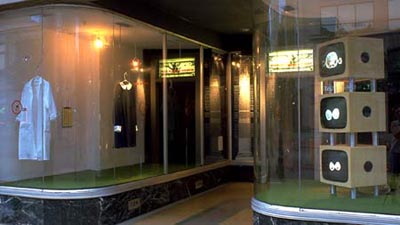SUBDIVIDED...RECONFIGURED...REUNITED
and PARADISE RECONFIGURED
by Paul Vanouse, 2000
VIDEO DOCUMENTATION
 In
1995, the National Institute of Health unvieled "The Visible Human Project"
-- a digital dataset containing 2,000 cross-sectional photos of the remains
of death-row inmate, Joseph Jernigan. Shortly following the completion
of the male cross-sections, an anonymous woman donated her body for the
same purposes. Initially, the "visible man" was called "Adam" by
project scientists, yet the name had already been trademarked by another
company and the drier title "visible man" was adopted instead. However,
both male and female datasets are still often referred to as "Adam" and
"Eve."
In
1995, the National Institute of Health unvieled "The Visible Human Project"
-- a digital dataset containing 2,000 cross-sectional photos of the remains
of death-row inmate, Joseph Jernigan. Shortly following the completion
of the male cross-sections, an anonymous woman donated her body for the
same purposes. Initially, the "visible man" was called "Adam" by
project scientists, yet the name had already been trademarked by another
company and the drier title "visible man" was adopted instead. However,
both male and female datasets are still often referred to as "Adam" and
"Eve."
 This story highlights the tendency of scientific rationalism
to borrow tropes from previous knowledge systems, especially of the Western
biblical tradition. (Similarly, the completion of the Human Genome
project has been called "the Holy Grail" of genetic research.) Subdivided...Reconfigured...Reunited
is an exploration of how the Old Testament story of Creation might continue
in order to rectify the seeming conflict between the distinct literary
traditions of ancient Judeo-Christian thought and contemporary Scientific
rationalism. To "fill in the gaps," the installation borrows writings
from the Western literary cannon, such as Old Testament, Shakespeare and
Milton as well as contemporary cultural and scientific literature.
This story highlights the tendency of scientific rationalism
to borrow tropes from previous knowledge systems, especially of the Western
biblical tradition. (Similarly, the completion of the Human Genome
project has been called "the Holy Grail" of genetic research.) Subdivided...Reconfigured...Reunited
is an exploration of how the Old Testament story of Creation might continue
in order to rectify the seeming conflict between the distinct literary
traditions of ancient Judeo-Christian thought and contemporary Scientific
rationalism. To "fill in the gaps," the installation borrows writings
from the Western literary cannon, such as Old Testament, Shakespeare and
Milton as well as contemporary cultural and scientific literature.
Physically, the installation is composed of wax-embedded
television monitors intended to echo the actual embalming of the two prior
to cross-sectioning. The 3 monitors are stacked (human-height), and
a custom electronic switching apparatus delivers appropriate texts and
("Visible Human" and video-probe microscope scanned) body sections to each
monitor.
 The
first form of the project "Subdivided, Reconfigured, Reunited" was a 3-channel,
non-interactive gallery work (see first image). The subsequent version
"Paradise Reconfigured", utilized user interactivity (see adjacent image).
Users could switch between one of three narrators at any point in the ongoing
narrative--Adam (Mr.), Eve (Mrs.), or the Scientist (Dr.).
The
first form of the project "Subdivided, Reconfigured, Reunited" was a 3-channel,
non-interactive gallery work (see first image). The subsequent version
"Paradise Reconfigured", utilized user interactivity (see adjacent image).
Users could switch between one of three narrators at any point in the ongoing
narrative--Adam (Mr.), Eve (Mrs.), or the Scientist (Dr.).
 Participants
interact with the work by touching areas of the window glass in front of
iconic vestaments (i.e. Adam is represented by an actual prison uniform).
Custom opto-electronic sensors behind the glass detect touch to alter the
narrative portrayed on wax-embeded monitors and exterior speakers.
Other indoor, gallery-based installations of the project used push-buttons
instead of opto-electronics.
Participants
interact with the work by touching areas of the window glass in front of
iconic vestaments (i.e. Adam is represented by an actual prison uniform).
Custom opto-electronic sensors behind the glass detect touch to alter the
narrative portrayed on wax-embeded monitors and exterior speakers.
Other indoor, gallery-based installations of the project used push-buttons
instead of opto-electronics.
Back to ArtDoc
 In
1995, the National Institute of Health unvieled "The Visible Human Project"
-- a digital dataset containing 2,000 cross-sectional photos of the remains
of death-row inmate, Joseph Jernigan. Shortly following the completion
of the male cross-sections, an anonymous woman donated her body for the
same purposes. Initially, the "visible man" was called "Adam" by
project scientists, yet the name had already been trademarked by another
company and the drier title "visible man" was adopted instead. However,
both male and female datasets are still often referred to as "Adam" and
"Eve."
In
1995, the National Institute of Health unvieled "The Visible Human Project"
-- a digital dataset containing 2,000 cross-sectional photos of the remains
of death-row inmate, Joseph Jernigan. Shortly following the completion
of the male cross-sections, an anonymous woman donated her body for the
same purposes. Initially, the "visible man" was called "Adam" by
project scientists, yet the name had already been trademarked by another
company and the drier title "visible man" was adopted instead. However,
both male and female datasets are still often referred to as "Adam" and
"Eve."
 This story highlights the tendency of scientific rationalism
to borrow tropes from previous knowledge systems, especially of the Western
biblical tradition. (Similarly, the completion of the Human Genome
project has been called "the Holy Grail" of genetic research.) Subdivided...Reconfigured...Reunited
is an exploration of how the Old Testament story of Creation might continue
in order to rectify the seeming conflict between the distinct literary
traditions of ancient Judeo-Christian thought and contemporary Scientific
rationalism. To "fill in the gaps," the installation borrows writings
from the Western literary cannon, such as Old Testament, Shakespeare and
Milton as well as contemporary cultural and scientific literature.
This story highlights the tendency of scientific rationalism
to borrow tropes from previous knowledge systems, especially of the Western
biblical tradition. (Similarly, the completion of the Human Genome
project has been called "the Holy Grail" of genetic research.) Subdivided...Reconfigured...Reunited
is an exploration of how the Old Testament story of Creation might continue
in order to rectify the seeming conflict between the distinct literary
traditions of ancient Judeo-Christian thought and contemporary Scientific
rationalism. To "fill in the gaps," the installation borrows writings
from the Western literary cannon, such as Old Testament, Shakespeare and
Milton as well as contemporary cultural and scientific literature.
 The
first form of the project "Subdivided, Reconfigured, Reunited" was a 3-channel,
non-interactive gallery work (see first image). The subsequent version
"Paradise Reconfigured", utilized user interactivity (see adjacent image).
Users could switch between one of three narrators at any point in the ongoing
narrative--Adam (Mr.), Eve (Mrs.), or the Scientist (Dr.).
The
first form of the project "Subdivided, Reconfigured, Reunited" was a 3-channel,
non-interactive gallery work (see first image). The subsequent version
"Paradise Reconfigured", utilized user interactivity (see adjacent image).
Users could switch between one of three narrators at any point in the ongoing
narrative--Adam (Mr.), Eve (Mrs.), or the Scientist (Dr.).
 Participants
interact with the work by touching areas of the window glass in front of
iconic vestaments (i.e. Adam is represented by an actual prison uniform).
Custom opto-electronic sensors behind the glass detect touch to alter the
narrative portrayed on wax-embeded monitors and exterior speakers.
Other indoor, gallery-based installations of the project used push-buttons
instead of opto-electronics.
Participants
interact with the work by touching areas of the window glass in front of
iconic vestaments (i.e. Adam is represented by an actual prison uniform).
Custom opto-electronic sensors behind the glass detect touch to alter the
narrative portrayed on wax-embeded monitors and exterior speakers.
Other indoor, gallery-based installations of the project used push-buttons
instead of opto-electronics.